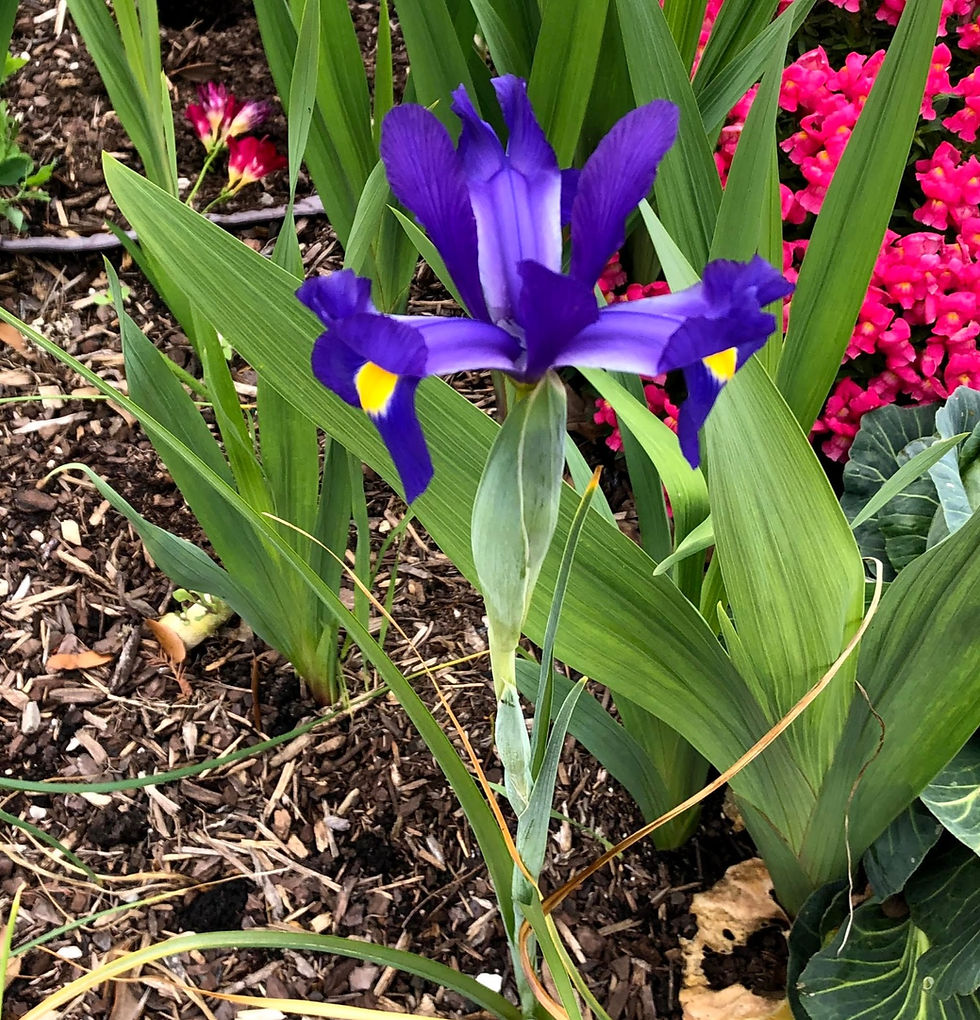Friday, May 15, 2020 – Name That Flower
- Mary Reed
- May 15, 2020
- 7 min read

Azalea
Azaleas are not really flowers, but flowering shrubs. However, they hold a soft spot in my heart because I lived in East Texas for 30 years where Tyler had an annual Azalea Festival which included local high school girls in antebellum costumes, the Azalea Belles.
According to Wikipedia, azaleas are in the genus Rhododendron. They bloom in the spring — May and June in the temperate Northern Hemisphere. Their flowers often last several weeks. Shade tolerant, they prefer living near or under trees.

Toxicity
In addition to being renowned for its beauty, the azalea is also highly toxic; it contains andromedotoxins in both its leaves and nectar, including honey from the nectar. Bees are deliberately fed on azalea/rhododendron nectar in some parts of Turkey, producing a mind-altering, potentially medicinal and occasionally lethal honey known as "mad honey." According to the ancient Roman historian Pliny the Elder in his Natural History, an army invading Pontus in Turkey was poisoned with such honey, resulting in their defeat. Azaleas and rhododendrons were once so infamous for their toxicity that to receive a bouquet of their flowers in a black vase was a well-known death threat.

Cultural Significance and Symbolism
In Chinese culture, the azalea is known as "thinking of home bush" (sixiang shu), and is immortalized in the poetry of Du Fu. The azalea is also one of the symbols of the city of São Paulo, Brazil.

Azalea Festivals
There are many azalea festivals all over the world every year, including in Japan, Korea and Hong Kong.
Many cities in the United States have festivals in the spring celebrating the blooms of the azalea, including:
The Azalea Trail is a designated path, planted with azaleas in private gardens, through Mobile, Alabama. The Azalea Trail Run is an annual road running event held there in late March. Mobile is also home to the Azalea Trail Maids, 50 women chosen to serve as ambassadors of the city while wearing antebellum dresses, who originally participated in a three-day festival, but now operate throughout the year.
The Azalea Society of America designated Houston, Texas, an "azalea city." The River Oaks Garden Club has conducted the Houston Azalea Trail every spring since 1935.



Daylily
I see daylilies along the Redding Trail and in the Addison Community Garden. According to Wikipedia, the daylily is a flowering plant in the genus Hemerocallis which comes from the Greek words ἡμέρα (hēmera) "day" and καλός (kalos) "beautiful." Despite the name, daylilies are not true lilies, although the flower has a similar shape. Although the buds and flowers are often used by humans in gourmet dishes, Hemerocallis species are toxic to cats and ingestion may be fatal. Treatment is usually successful if started before kidney failure has developed.

Daylilies have been found growing wild for millennia throughout China, Mongolia, Northern India, Korea and Japan. There are thousand-year-old Chinese paintings showing orange daylilies that are remarkably similar to the flowers that grace modern gardens.
It is theorized that daylilies were first brought to Europe by traders along the silk routes from Asia. However, it was not until 1753 that daylilies were given their botanic name of Hemerocallis by the Swedish naturalist Carl Linnaeus.
Daylilies were first brought to North America by early European immigrants, who packed the roots along with other treasured possessions for the journey to the New World. By the early 1800s, the plant had become naturalized, and a bright orange clump of flowers was a common site in many homestead gardens.

The flowers of Hemerocallis citrina are edible and are used in Chinese cuisine. They are sold — fresh or dried — in Asian markets as gum jum or yellow flower vegetables. They are used in hot and sour soup, daylily soup, Buddha's delight and moo shu pork.

Gladiolus
One gardener has several shades of gladiola in the Addison Community Garden. My grandmother used to grow these when she lived in the house next door. I always loved seeing their pastel colors. According to Wikipedia, it is sometimes called the “sword lily,” but is usually called by its generic name (plural gladioli). The genus Gladiolus contains about 300 species.

In culture
· Gladiolus is the birth flower of August.
· Gladioli are the flowers associated with a 40th wedding anniversary.
· "Gladiolus" was the word Frank
Neuhauser correctly spelled to win the First National Spelling Bee in 1925.
· The Australian comedian and personality Dame Edna Everage's signature flowers are gladioli, which she refers to as "gladdies".
· The singer Morrissey is known to dance with gladioli hanging from his back pocket or in his hands, especially during the era of The Smiths. This trait of his was made known in the music video for "This Charming Man," where he swung a bunch of yellow gladioli while singing.

Impatiens
The flower beds near the front door of the Addison Athletic Club are full of beautiful, colorful impatiens. According to Wikipedia, impatiens is a genus of more than 1,000 species of flowering plants, widely distributed throughout the Northern Hemisphere and the tropics. Common names in North America include impatiens, jewelweed, touch-me-not, snapweed and patience. In the British Isles by far the most common names are impatiens and busy lizzie. “Busy lizzie” is also found in the American literature. The invasive alien Impatiens glandulifera is commonly called Policeman's helmet in the UK. The scientific name Impatiens (Latin for "impatient") and the common name touch-me-not refer to the explosive dehiscence of the seed capsules. The mature capsules burst, sending seeds up to several meters away.
North American impatiens have been used as herbal remedies for the treatment of bee stings, insect bites, and stinging nettle rashes. They are also used after poison ivy contact to prevent a rash from developing. Impatiens glandulifera is one of the Bach flower remedies, flower extracts used as herbal remedies for physical and emotional problems. It is included in the "Rescue Remedy" or "Five Flower Remedy," a potion touted as a treatment for acute anxiety and which is supposed to be protective in stressful situations. In ancient China, Impatiens petals mashed with rose and orchid petals and alum were used as nail polish; leaving the mixture on the nails for some hours colored them pink or reddish.

Iris
In the Addison Community Garden is a beautiful iris. I have an affinity for irises because my mother’s middle name was Iris. According to Wikipedia, iris is a genus of 260–300 species of flowering plants with showy flowers. It takes its name from the Greek word for a rainbow, which is also the name for the Greek goddess of the rainbow, Iris. Some authors state that the name refers to the wide variety of flower colors found among the many species. Nearly all species are found in temperate Northern hemisphere zones, from Europe to Asia and across North America. Although diverse in ecology, Iris is predominantly found in dry, semi-desert, or colder rocky mountainous areas, other habitats include grassy slopes, meadowlands, bogs and riverbanks.

Presby Memorial Iris Gardens in New Jersey, for example, is a living iris museum with over 10,000 plants, while in Europe the most famous iris garden is arguably the Giardino dell'Iris in Florence (Italy) which every year hosts a well-attended iris breeders' competition. Irises, especially the multitude of bearded types, feature regularly in shows such as the Chelsea Flower Show.

Rhizomes — modified subterranean plant stems that send out roots and shoots from its nodes — of the German Iris and Sweet Iris are used in perfume and medicine, though more common in ancient times than today. Today, iris essential oils from flowers are sometimes used in aromatherapy as sedative medicines. The dried rhizomes are also given whole to babies to help in teething. Gin brands such as Bombay Sapphire and Magellan Gin use orris root — roots of the bearded iris species German Iris and Sweet Iris — and sometimes iris flowers for flavor and color.

The artist Vincent van Gogh painted several famous pictures of irises. The iris is one of the flowers listed as birth flower for February. In Christianity, the iris represents Our Lady of Sorrows as its sharp leaves are like swords. The Iris croatica is the unofficial National Flower of Croatia. Iris nigricans, the Black Iris, is the national flower of Jordan. Iris bismarckiana, the Nazareth Iris, is the symbol of the city of Upper Nazareth. In 1998, the Dwarf Lake Iris was designated the state wildflower of Michigan. In 1990, the Louisiana iris was voted the state wildflower of Louisiana, though the state flower is the magnolia blossom. In Iran and Kashmir, Iris kashmiriana and Iris germanica are most commonly grown on Muslim graveyards. The species Iris versicolor is also the provincial flower of Quebec. Also, it is the official flower of Kappa Pi International Honorary Art Fraternity.

The fleur-de-lis, a stylized iris, first occurs in its modern use as the emblem of the House of Capet. The fleur-de-lis has been associated with France since Louis VII adopted it as a symbol in the 12th century. The yellow fleur-de-lis reflects the yellow iris, common in Western Europe. Contemporary uses can be seen in the Quebec flag, logo of the New Orleans Saints professional football team and on the flag of Saint Louis, Missouri.

Passion Flower
One of the gardeners in the Addison Community Garden has a very large vine of passion flowers in order to attract pollinators to the garden. According to Wikipedia, Passiflora, known also as the passion flowers or passion vines, is a genus of about 550 species of flowering plants. Passiflora incarnata (maypop) leaves and roots have a long history of use as a traditional medicine by Native Americans in North America and were adapted by European colonists. The fresh or dried leaves of maypop are used to make a tea that is used as a sedative. Passion flower as dried powder or an extract is used as a dietary supplement. Passion flowers are not recommended during pregnancy because it may induce contractions. Consuming passion flower products may cause drowsiness, nausea, dizziness, abnormal heart rhythms, asthma, or rhinitis.

The "Passion" in "passion flower" refers to the passion or short final period of the life of Jesus in Christian theology. In the 15th and 16th centuries, Spanish Christian missionaries adopted the unique physical structures of this plant — particularly the numbers of its various flower parts — as symbols of the last days of Jesus and especially his crucifixion:
· The pointed tips of the leaves were taken to represent the Holy Lance.
· The tendrils represent the whips used in the flagellation of Christ.
· The ten petals and sepals represent the ten faithful apostles — excluding St. Peter the denier and Judas Iscariot the betrayer.
· The flower's radial filaments — which can number more than a hundred and vary from flower to flower — represent the crown of thorns.
· The chalice-shaped ovary with its receptacle represents a hammer or the Holy Grail.
· The 3 stigmas represent the 3 nails and the 5 anthers below them the 5 wounds — four by the nails and one by the lance.
· In addition, the flower keeps open three days, symbolizing the three years' ministry.
Kommentare